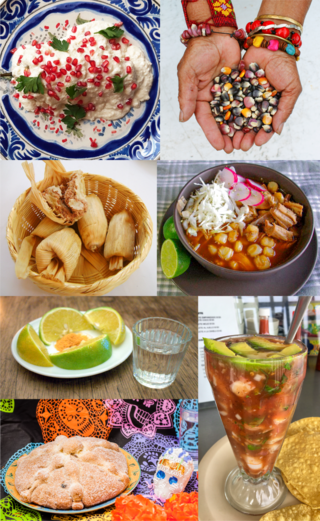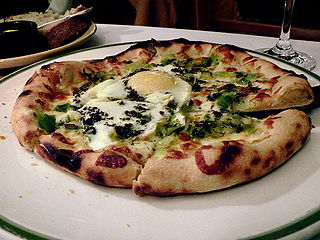External links
| Historical | |||||||||||||
|---|---|---|---|---|---|---|---|---|---|---|---|---|---|
| Regional |
| ||||||||||||
| Ethnic | |||||||||||||
| List articles | |||||||||||||
| Miscellaneous | |||||||||||||
| Drinks | |||||||||||||
Below is a list of regional dishes which together form the Cuisine of the United States.
This region encompasses the cuisines of the states of New York, New Jersey, Pennsylvania, Delaware, and Maryland, as well as Washington, D.C. The influences on cuisine in this region of the United States are extremely eclectic as it has been, and continues to be, a gateway for international culture as well as a gateway for new immigrants.
This region draws its culinary roots most significantly from the cuisines of Central, Northern and Eastern Europe, and Indigenous cuisine of the Americas.
This region traces its roots to traditional English cuisine and Native American cuisine of the Abenaki, Narragansett, Niantic, Wabanaki, Wampanoag, and other native peoples. It also includes influences from Irish, French, Italian, and Portuguese cuisine, among others.
This region traces its roots to traditional Indigenous cuisine of the Americas (e.g., Cherokee, Caddo, Choctaw, and Seminole), English cuisine, the cuisines of enslaved Africans trafficked to the North American colonies through the Atlantic slave trade, French cuisine, Cuban cuisine, and Spanish cuisine.
This region traces its roots to Spanish cuisine, Native American cuisine, Mexican cuisine, and cowboy cuisine. Its boundaries extend through Arizona, New Mexico, Texas and includes portions of California, Colorado, Nevada, and Utah.

American cuisine consists of the cooking style and traditional dishes prepared in the United States. It has been significantly influenced by Europeans, Indigenous Americans, Africans, Latin Americans, Asians, Pacific Islanders, and many other cultures and traditions. Principal influences on American cuisine are European, Native American, soul food, regional heritages including Cajun, Louisiana Creole, Pennsylvania Dutch, Mormon foodways, Texan, Tex-Mex, New Mexican, and Tlingit, and the cuisines of immigrant groups such as Chinese American, Italian American, Jewish American, Greek American and Mexican American. The large size of America and its long history of immigration have created an especially diverse cuisine that varies by region.

A cuisine is a style of cooking characterized by distinctive ingredients, techniques and dishes, and usually associated with a specific culture or geographic region. Regional food preparation techniques, customs, and ingredients combine to enable dishes unique to a region.

Fusion cuisine is a cuisine that combines elements of different culinary traditions that originate from different countries, regions, or cultures. Cuisines of this type are not categorized according to any one particular cuisine style and have played a part in many contemporary restaurant cuisines since the 1970s.

Mexican cuisine consists of the cooking cuisines and traditions of the modern country of Mexico. Its earliest roots lie in Mesoamerican cuisine. Mexican cuisine ingredients and methods begin with the first agricultural communities such as the Olmec and Maya who domesticated maize, created the standard process of nixtamalization, and established their foodways. Successive waves of other Mesoamerican groups brought with them their cooking methods. These included: the Teotihuacanos, Toltec, Huastec, Zapotec, Mixtec, Otomi, Purépecha, Totonac, Mazatec, Mazahua, and Nahua. With the Mexica formation of the multi-ethnic Triple Alliance, culinary foodways became infused.

Soul food is the ethnic cuisine of African Americans. It originated in the American South from the cuisines of enslaved Africans trafficked to the North American colonies through the Atlantic slave trade during the Antebellum period and is closely associated the cuisine of the American South. The expression "soul food" originated in the mid-1960s when "soul" was a common word used to describe African-American culture. Soul food uses cooking techniques and ingredients from West African, Central African, Western European, and Indigenous cuisine of the Americas.

The cuisine of the Southern United States encompasses diverse food traditions of several subregions, including cuisine of Southeastern Native American tribes, Tidewater, Appalachian, Ozarks, Lowcountry, Cajun, Creole, African American cuisine and Floribbean cuisine. In recent history, elements of Southern cuisine have spread to other parts of the United States, influencing other types of American cuisine.

The cuisine of California reflects the diverse culture of California and is influenced largely by European American, Hispanic American, East Asian and Oceanian influences, and Western European influences, as well as the food trends and traditions of larger American cuisine.

Jambalaya is a savory rice dish of mixed origins that developed in the U.S. state of Louisiana apparently with African, Spanish, and French influences, consisting mainly of meat or seafood, and vegetables mixed with rice and spices. West Africans and Spanish people each had versions of jambalaya in their respective countries. Historian Ibraham Seck states Senegalese people were making jambalaya. The French introduced tomato to West Africans and they incorporated the crop into their one-pot rice dishes that created jambalaya and enhanced jollof rice. Spanish people made paella which is also a one-pot rice dish cooked with meats and vegetables. These styles of cuisines blended in Louisiana and resulted in cultural and regional variations of the dish.

Latin American cuisine is the typical foods, beverages, and cooking styles common to many of the countries and cultures in Latin America. Latin America is a highly racially, ethnically, and geographically diverse with varying cuisines. Some items typical of Latin American cuisine include maize-based dishes arepas, empanadas, pupusas, tacos, tamales, tortillas and various salsas and other condiments. Sofrito, a culinary term that originally referred to a specific combination of sautéed or braised aromatics, exists in Latin American cuisine. It refers to a sauce of tomatoes, roasted bell peppers, garlic, onions and herbs. Rice, corn, pasta, bread, plantain, potato, yucca, and beans are also staples in Latin American cuisine.

California cuisine is a food movement that originated in Northern California. The cuisine focuses on dishes that are driven by local and sustainable ingredients with an attention to seasonality and an emphasis on the bounty of the region.

The cuisine of the Southwestern United States is food styled after the rustic cooking of the Southwestern United States. It comprises a fusion of recipes for things that might have been eaten by Spanish colonial settlers, cowboys, Mountain men, Native Americans, and Mexicans throughout the post-Columbian era; there is, however, a great diversity in this kind of cuisine throughout the Southwestern states.
African cuisine is a staple of the continent's culture, and its history is entwined with the story of the native people of Africa. The foods that native Africans eat have been influenced by their religions, as well as by their climates and lifestyles. The first Africans to inhabit the continent were hunter-gatherers who ate what they could find in nature. As agriculture became more common in Africa, so did agriculture-based diets.
Peruvian cuisine reflects local practices and ingredients including influences mainly from the indigenous population, including the Inca, and cuisines brought by immigrants from Europe, Asia, and Africa. Without the familiar ingredients from their home countries, immigrants modified their traditional cuisines by using ingredients available in Peru.
The global cuisine or world cuisine is a cuisine that is practiced around the world. A cuisine is a characteristic style of cooking practices and traditions, often associated with a specific region, country or culture. To become a global cuisine, a local, regional or national cuisine must spread around the world, its food served worldwide. There have been significant improvements and advances during the 20th century in food preservation, storage, shipping and production, and today many countries, cities and regions have access to their traditional cuisines and many other global cuisines.

The cuisines of Oceania include those found on Australia, New Zealand, and New Guinea, and also cuisines from many other islands or island groups throughout Oceania.
Southern fusion is a fusion cuisine that blends or combines cuisine elements from the American southern states or other cultures with traditional Southern cooking. The origin of Southern fusion took place before there was a defining phrase for this pattern of cooking. Traditional southern food has originated from African, European and Hispanic cultures. Due to this fact, Southern fusion usually occurs naturally between different regions and cultures through immigration. Southern fusion cuisine can mean a blend of various Southern styles of cooking, or a blend of Southern style with another style of cooking altogether. Prevalent Southern fusion cuisines include Tex-Mex, although there are countless combinations of cuisines that would fall under the category of Southern fusion. Many modern restaurants in the southern states feature elements of Southern fusion cooking.